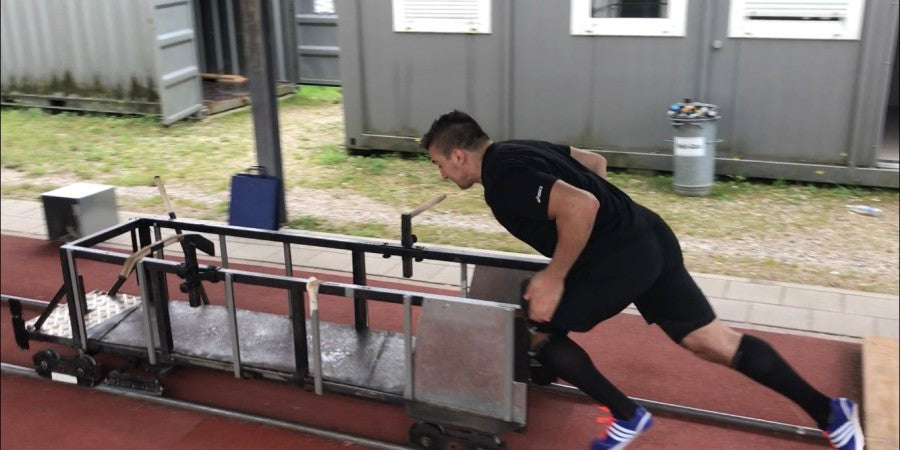Originally published in Functional Training Magazine
Getting fitter is the goal of every exerciser. The first question that arises is: what is fitter? Everyone defines this differently. The reason for this is simple: Fitness is specific. The definitions differ greatly, especially in the context of competitive sport. And with it the training.
Getting fitter is the goal of every exerciser. The first question that arises is: what is fitter? Everyone defines this differently. The reason for this is simple: fitness is specific. The definitions differ greatly, especially in the context of competitive sport. And with it the training. A fact that is too often neglected. Training is adaptation to a specific stressor. This stressor must be directly or indirectly related to the desired performance. Put simply, if you want to run a marathon, you have to run. If you want to ride a stage of the Tour de France, you have to ride a bike. If you want to score more goals, you have to play more football.
The less specific the training, the less specific the performance. A simple example from top-class sport is the comparison of the best performances of Ashton Eaton, the 4-times world champion, 2-times Olympic champion and world record holder in decathlon and thus the most successful decathlete of all time and therefore a very "fit" athlete with the records of the US high school and the world record. With the US High School it should be noted that this is not the university but similar to the high school, i.e. it is 17- and 18-year-old athletes who set these records. The comparison of these best performances is as follows:
Comparison: Best Ashton Easton / US High School Record / World Record
100m sprint: 10.21s / 10.01s / 9.58s
Shot put: 15.40m / 20.65m / 23.12m
High Jump: 2.05m / 2.31m / 2.45m
Pole Vault: 5.05m / 5.57m / 6.16m
1500m: 4:14 mins / 3:38 mins / 3:26 mins
How can it be that one of the most outstanding and therefore fittest athletes of all time, Ashton Eaton, falls so far behind, especially against 17 and 18-year-old students and of course also against the best athletes in the individual disciplines? The differences are serious. On Usain Bolt and the 100m world record he loses almost 10m, in the shot put it is almost 8m difference and over 1500m he loses a complete lap on the track against the world record holder.
The two key reasons for this are:
mechanics and anatomy
Structure determines function - one of the most important basics from an anatomical and thus mechanical point of view in relation to competitive sports and thus a high level of fitness. The Olympic champion in shot put is Randy Barnes, who is 1.94m tall and weighs around 132kg, Ashton Eaton, who is 1.85m tall and weighs around 84kg in terms of maximum strength, which is crucial for accelerating the ball , a big step ahead. An important factor that is decisive on 8m difference in the best performances. Over 1500m, double Olympic champion Hicham El Guerrouj with a height of 1.76m and a body weight of approx. 58kg is a big step ahead in terms of running mechanics and efficiency, which explains this difference.
In addition to less controllable factors such as mechanics and anatomy, the second decisive and above all very controllable factor is:
training focus
The shot putter Randy Barnes only trains directly and indirectly for the shot put, depending on the training phase on 4 to 6 days a week. How often does Ashton Eaton train in the shot put, hardly more than one day a week. With the large number of disciplines, there is no longer any training time left. 1500m world record holder Hicham El Guerrouj also trains exclusively for the 1500m. While for decathletes like Ashton Eaton it is most common not to practice this discipline at all, as improvement in the maximum range of this performance has a potentially negative effect on all other nine disciplines that primarily require short explosive performance. The training volume required for 1500m would also take up too much time and too much regenerative capacity, which also has a potentially negative effect on the performance of all other new disciplines.
Conversely, for the training of each individual, this clearly illustrates that, in addition to mechanics and anatomy as the basis, the specific focus of the training plays the decisive role in the specific adaptation.
Especially in the context of strength training, if you want to get better at pull-ups, do more and more pull-ups instead of lat pulldowns. If you want to get better at squats, squat more and more frequently instead of leg presses and leg extensions. If you want to get better at deadlifts, do more and more frequent deadlifts instead of half a dozen assistance exercises.
Good luck with defining your fitness goals and training accordingly!
Picture: Bob athlete Fredrick Lüthcke pushing the summer version of a bob.

